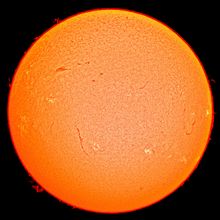In physics, energy is the quantitative property that must be transferred to a body or physical system to perform work on the body, or to heat it. Energy is a conserved quantity; the law of conservation of energy states that energy can be converted in form, but not created or destroyed. The unit of measurement in the International System of Units (SI) of energy is the joule, which is the energy transferred to an object by the work of moving it a distance of one metre against a force of one newton.
Common forms of energy include the kinetic energy of a moving object, the potential energy stored by an object's position in a force field (gravitational, electric or magnetic), the elastic energy stored by stretching solid objects, the chemical energyreleased when a fuel burns, the radiant energy carried by light, and the thermal energydue to an object's temperature.
Mass and energy are closely related. Due to mass–energy equivalence, any object that has mass when stationary (called rest mass) also has an equivalent amount of energy whose form is called rest energy, and any additional energy (of any form) acquired by the object above that rest energy will increase the object's total mass just as it increases its total energy. For example, after heating an object, its increase in energy could be measured as a small increase in mass, with a sensitive enough scale.
Living organisms require energy to stay alive, such as the energy humans get from food. Human civilization requires energy to function, which it gets from energy resources such as fossil fuels, nuclear fuel, or renewable energy. The processes of Earth's climate and ecosystem are driven by the radiant energy Earth receives from the Sun and the geothermal energy contained within the earth.
The total energy of a system can be subdivided and classified into potential energy, kinetic energy, or combinations of the two in various ways. Kinetic energy is determined by the movement of an object – or the composite motion of the components of an object – and potential energy reflects the potential of an object to have motion, and generally is a function of the position of an object within a field or may be stored in the field itself.
While these two categories are sufficient to describe all forms of energy, it is often convenient to refer to particular combinations of potential and kinetic energy as its own form. For example, macroscopic mechanical energy is the sum of translational and rotational kinetic and potential energy in a system neglects the kinetic energy due to temperature, and nuclear energy which combines potentials from the nuclear force and the weak force), among others.[citation needed]
| Type of energy | Description |
|---|---|
| Mechanical | the sum of macroscopic translational and rotational kinetic and potential energies |
| Electric | potential energy due to or stored in electric fields |
| Magnetic | potential energy due to or stored in magnetic fields |
| Gravitational | potential energy due to or stored in gravitational fields |
| Chemical | potential energy due to chemical bonds |
| Ionization | potential energy that binds an electron to its atom or molecule |
| Nuclear | potential energy that binds nucleons to form the atomic nucleus (and nuclear reactions) |
| Chromodynamic | potential energy that binds quarks to form hadrons |
| Elastic | potential energy due to the deformation of a material (or its container) exhibiting a restorative force as it returns to its original shape |
| Mechanical wave | kinetic and potential energy in an elastic material due to a propagated deformational wave |
| Sound wave | kinetic and potential energy in a fluid due to a sound propagated wave (a particular form of mechanical wave) |
| Radiant | potential energy stored in the fields of propagated by electromagnetic radiation, including light |
| Rest | potential energy due to an object's rest mass |
| Thermal | kinetic energy of the microscopic motion of particles, a form of disordered equivalent of mechanical energy |
| Energy | |
|---|---|
 The Sun is the source of energy for most of life on Earth. It derives its energy mainly from nuclear fusion in its core, converting nuclear binding energy to other forms such as radiant energy as protons are combined to form helium. This energy is transported to the sun's surface then released into space mainly in the form of radiant (light) energy. | |
Common symbols | E |
| SI unit | joule |
Other units | kW⋅h, BTU, calorie, eV, erg, foot-pound |
| In SI base units | J = kg m2 s−2 |
| Extensive? | yes |
| Conserved? | yes |
| Dimension | M L2 T−2 |
| Thermodynamics |
|---|
 |
https://en.wikipedia.org/wiki/Energy
No comments:
Post a Comment